County Infirmary
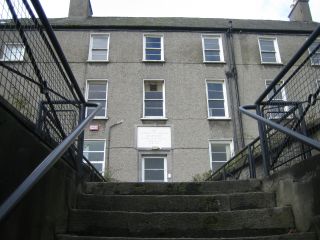 Steps into the hospital from Bridge Street. Photo: © Navan & District Historical Society
Steps into the hospital from Bridge Street. Photo: © Navan & District Historical Society
For over 200 years the County Infirmary has ministered to the sick in Navan and the surrounding districts, a record which few other such institutions can surpass. An interesting account of its foundation and early years has survived, from which we quote-
"The gentlemen in the neighbourhood of Navan, from their observation of the various calamities and miseries the poor undergo, for want of proper and timely assistance in their several maladies and disorders, did propose to found a County Hospital. Accordingly a subscription was opened at an Assembly at Navan, the first of October 1753; and soon after the Foundation of a County Hospital was laid on a convenient and healthy situation, on an eminence at the entrance into the town."
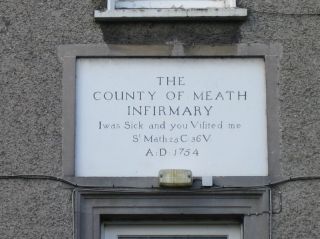
At first it contained only 10 beds, and 87 out patients receiving treatment in the opening year.
But in 1768 the Corporation granted a
rood of ground at a peppercorn rent for
an extension to 20 beds,
the Portreeve becoming an ex offico member of the Board of Governors.
Photo: © Navan & District Historical Society
In 1866 considerable reconstruction was done at a cost of £790 by Messrs. Curry and Flood. From that time until the modernisation programme of the past few years there seems to have been little change in the structure, apart from that necessitated by the vast improvement in the care and treatment of the sick. While the Infirmary was under construction the sick were attended by the physician, Dr. Knox, in their homes, and a dispensary set up under Mr. Sempell, resident apothecary. His son, "a sober, sensible young man," was then studying surgery and anatomy at Edinburgh, "in order to attend this Hospital." Until he returned, "the several gentlemen of the profession of surgery in the neighbourhood... generously offered their attendance upon my extraordinary occasions."
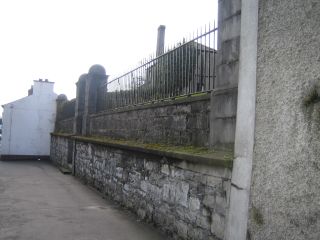
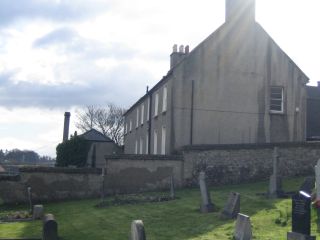
(above) The Infirmary viewed from the Graveyard in the Church of Ireland and its gates (above right)
Photos: © Navan & District Historical Society
***
A brief account of the Rise and Progress of the County of Meath Infirmary
To the account of the foundation of this venerable institution is appended a list of the ailments treated in the year 1753-54, in order to induce "the Benevolent and Generous to contribute to so useful and necessary a Foundation." Of the 82 cases listed, most are stated to have been cured, and only two died. Among the cures effected was a case of "Hickcough and Convulsions occasioned by a fright."
The number of patients was usually greater than the number of beds, and many must have lain on straw pallets on the ground. Sand and straw for the floors were one of the principal items of expense, and were also wine and porter, and leeches for bleeding the patients. 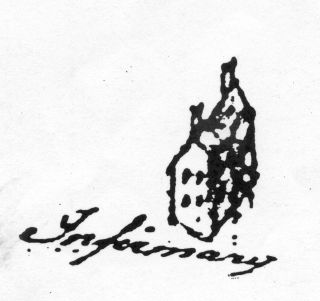
Between 1767 and 1775 there was a yearly average of 100 intern patients,and a rather greater number of externs. In 1774 the salary of the Surgeon was £97, and the total expenses about £300. The income from donations, and Parliamentary and County bounties was barely adequate, and the annual subscriptions were often unpaid. A printed statement of accounts, with a list of subscriptions and arrears of same, was therefore circulated.
Sketch of the Informary from 1756 map (right)
***
A general account of the County of Meath Infirmary, from the opening March 1st 1767 to April 1775.
Printed by William Sleator at No. 51 Castle Street, Dublin.
In the early 19th century the Infirmary was described as "a plain building, not well adapted to its purpose," while by contrast the new Fever Hospital contained "ample accommodation of a superior kind."
****
Lewis' Topographical Directory, 1837
An Intern Register, and a Medical Note Book of this period are still preserved, together with an Account Book (1848-84). From these it appears that the Infirmary never accomodated more than 35 patients, until the new wards were errected in 1866.
The age of modern surgery had dawned, and in 1848-49 the total expenditure of £1,712 included £10 paid to Luke Byron, M.D., of Knock Boyne, the Surgeon, for surgical instruments, and £1-10-0 to William Jones, the Porter for wooden legs.
The old alcohol and bleeding treatment, however, still lingered on, some £90 being spent on wine, porter and leeches.
Before Luke Byron's time, John Browne, M.D., was Surgeon for nearly 11 years (1815-26), and admitted 2,177 patients during his term of office. John Gibney, Peter Gilroy, and Philip Hazlewood were also among the Navan practioners of this period.
In 1848 Francis Dansey Hamilton became Surgeon to the Infirmary, and Mr. Timmons, who kept a shop in Market Square, was Apothecary and Secretary.
Mrs. Davy was still Matron in 1873, in which year the Governors voted her £5 for a sea side holiday. William Jones is still listed as Porter in the 1877 Census, and he also held the office of Bailiff.
A century earlier Mrs. Goldsmith had been Matron for a number of years. She was the widow of the Rev. Henry Goldsmith, Curate of Kilkenny West, and eldest brother of the famous Oliver.
Prior's Life of Goldsmith, Volume 2, page 563.
Source: Riocht na Midhe, 1963, Vol. 111, No. 1.
Photos added by N&DHS
***
The London Times 25 May 1846; Glanders in the Human Subject
A case of this frightful disease has recently occurred at Navan. The sufferer was a boy named Christopher Clarke, of Rathcoune, about 17 years old, who caught the disease from a glandered horse belonging to his father, which he cared and attended. The infection was received by the boy through a slight cut on one of his fingers. He was brought to the County of Meath Infirmary, at Navan, where death ended his sufferings on last Thursday week. As he has approached his person presented a most appalling spectacle.
Mr. William Timmon, apothecary to the institution, informed me that three former patients who died in the infirmary of this disease, within two years were similarly affected. I have been informed by a medical gentleman that the late Archdeacon D’Lacy of Meath, after losing four hunters, had the remainder of his stud cured of glanders by a man residing near Dundalk.
***
Meath Chronicle, 10 April 1909, Navan Urban District Council - The Watson Memorial
The Clerk reported that he had received no reply from Mr. Watkins re the proposed Watson memorial. The Chairman said the watering trough proposed might be more useful in that portion of the town leading up to the station.
Mr. Timmon: What a lovely thing it would be to have a very nice fountain in place of the present weigh house, with gold fish.
Mr. Mangan: You are interested there - it is no wonder (laughter).
Chairman: Rome was not built in a day.
Mr. Timmon: And especially if we could run a pipe from the Spa, and a force pump to pump it- that would be the dart (laughter).
Mr. Farrell: Would the gold fish require medicine?
Mr. Timmon: A little chloride of gold, no more (laughter).
Mr. Finucane: They would not have far to go.
***
Meath Chronicle, 24 April 1909 - The Watson Memorial
A a meeting of the County Meath Infirmary Committee on the 13th inst. a letter was read from Mr. O. F. Matthews, Boyne View with reference to the Watson Memorial Bed, stating he agreed with the Committee as to the course proposed with regard to the investment of the £500 subscribed, the income to be devoted to the institution. The Secretary was instructed to write to Mr. Matthews supporting the desirability of investing the money in Japanese 4 1/2 per cent bonds.
***